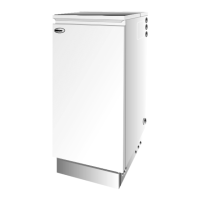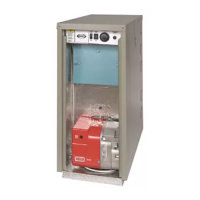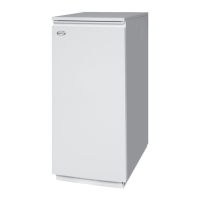27
Grant Vortex Indoor/Utility, System and Boiler House Oil Boilers
5 - CONDENSATE DISPOSAL
Connections into a rainwater hopper, external drain or
gulley should be terminated inside the hopper/drain/
gulley below the grid level but above the water level.
Condensate disposal pipes should not be connected
directly into rainwater downpipes or to waste/soil
systems connected to septic tanks.
Condensate should not be discharged into 'grey water'
systems that re-use water used in the home (not
including water from toilets).
It should be noted that connection of a condensate pipe
to the drain may be subject to local Building Control
requirements.
Condensate disposal pipework must be plastic (plastic
waste or overflow pipe is suitable).
IMPORTANT: Copper or steel pipe is NOT suitable
and MUST NOT be used.
Condensate disposal pipes should have a minimum
'nominal' diameter of 22 mm (¾") - e.g. use 21.5 mm
OD polypropylene overflow pipe.
Condensate disposal pipes must be fitted with a fall
(away from the boiler) of at least 2.5° (~45 mm fall
per metre run).
Note: Where it is not possible for the pipe to fall towards the
point of discharge - either internally into a waste system or
externally to a gulley (e.g. for boilers installed in a basement),
it will be necessary to use a condensate pump.
Condensate disposal pipes should be kept as short as
possible and the number of bends kept to a minimum.
Pipes should be adequately fixed to prevent sagging,
i.e. at no more than 0.5 metre intervals.
External pipework
Ideally, external pipework, or pipework in unheated
areas, should be avoided. If unavoidable, external
pipework should be kept as short as possible (less than
3 metres) and 32 mm waste pipe used to minimise the
risk of ice blocking the pipe in freezing conditions.
The number of bends, fittings and joints on external
pipes should be kept to a minimum to reduce the risk
of trapping condensate.
Note: For boiler installed in an unheated area such as
an outhouse or garage, all condensate pipework should
be considered as an ‘external’.
To keep external pipework to a minimum, locate the
soakaway as close as possible to the boiler but ensure
it is at least 1 metre from building foundations and
away from other services, e.g. gas, electricity, etc.
The condensate pipe may be run above or below
ground level and can enter either the top or side of the
soakaway tube. Refer to Fig.16.
Ensure that the drainage holes in the soakaway tube
face away from the building.
Connections
5.2
Pipework
5.3
Condensate soakaway
5.4
Fig. 16 - Purpose made condensate soakaway
Ground level
32 mm waste pipe external to the building
2.5 fall
O
25 mm
300 mm
400 mm
min.
Two rows of3x12mm
holes at 25 mm centres
and 50 mm from the bottom
of the tube. Holes facing
away from the property.
Cement seal
100 mm
plastic
tube
Sealed
end
Backfill with 10 mm
limestone chippings
